北师大版(2019)必修第三册Unit 9 Learning 语法知识课件(共25张PPT)
文档属性
| 名称 | 北师大版(2019)必修第三册Unit 9 Learning 语法知识课件(共25张PPT) |  | |
| 格式 | pptx | ||
| 文件大小 | 495.8KB | ||
| 资源类型 | 教案 | ||
| 版本资源 | 北师大版(2019) | ||
| 科目 | 英语 | ||
| 更新时间 | 2024-04-14 21:17:52 | ||
图片预览


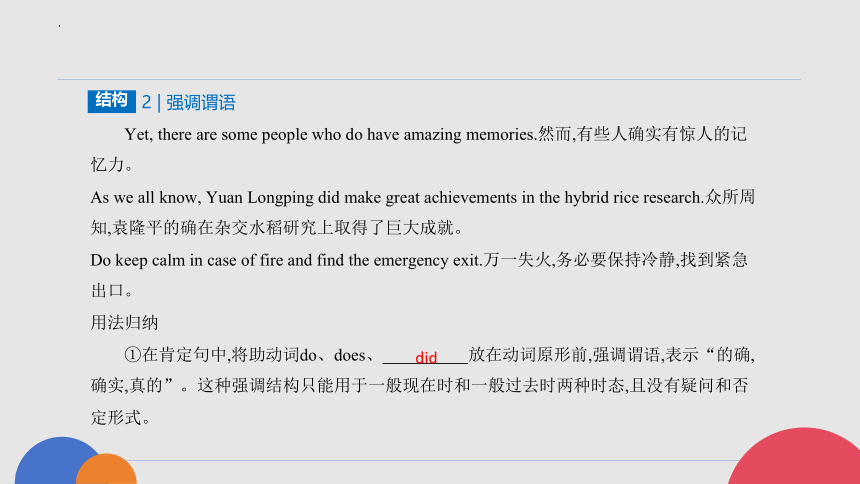
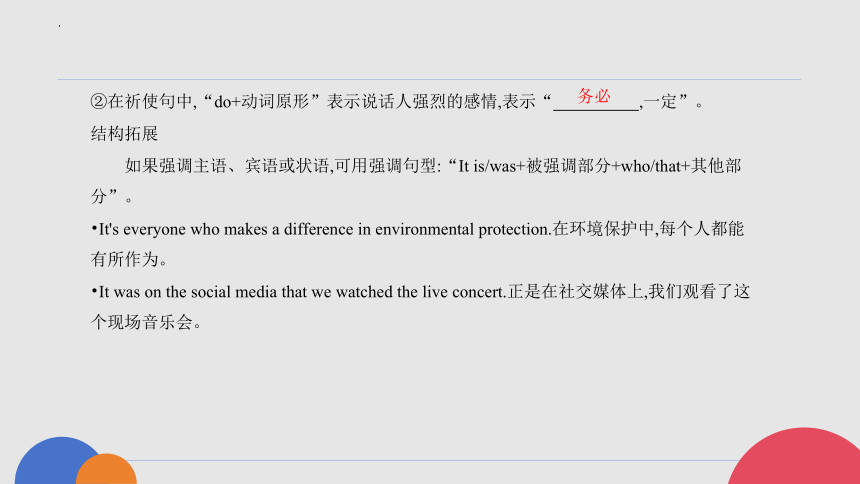

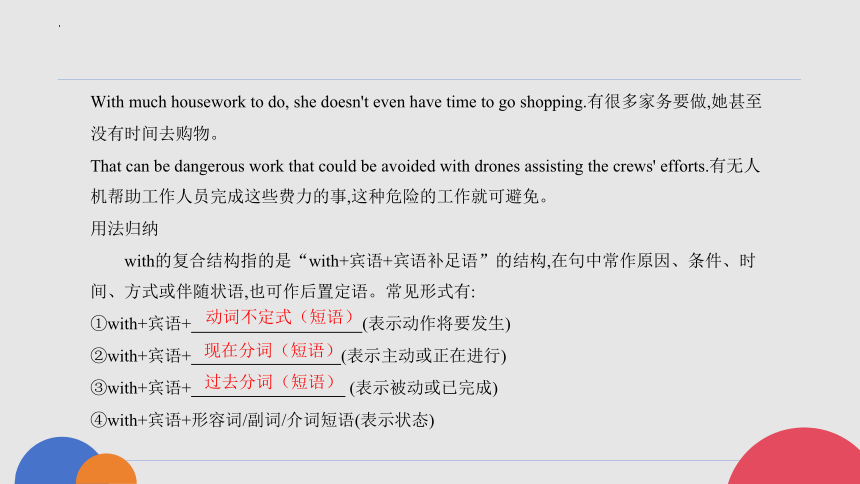

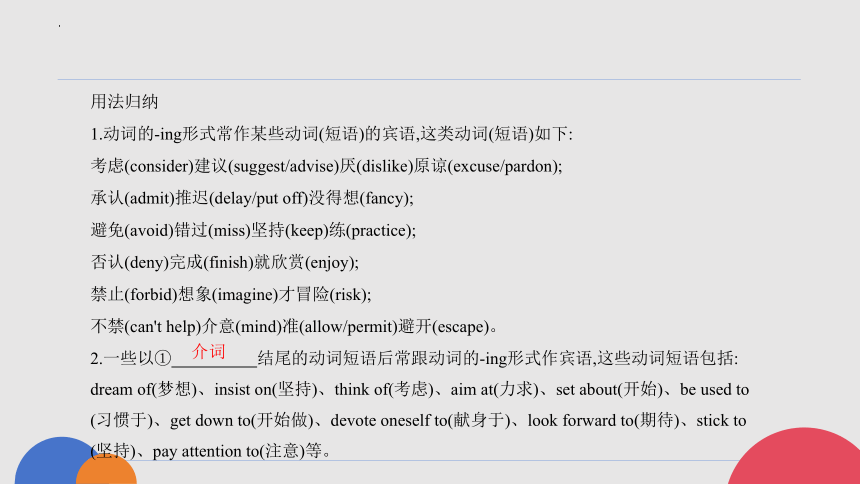
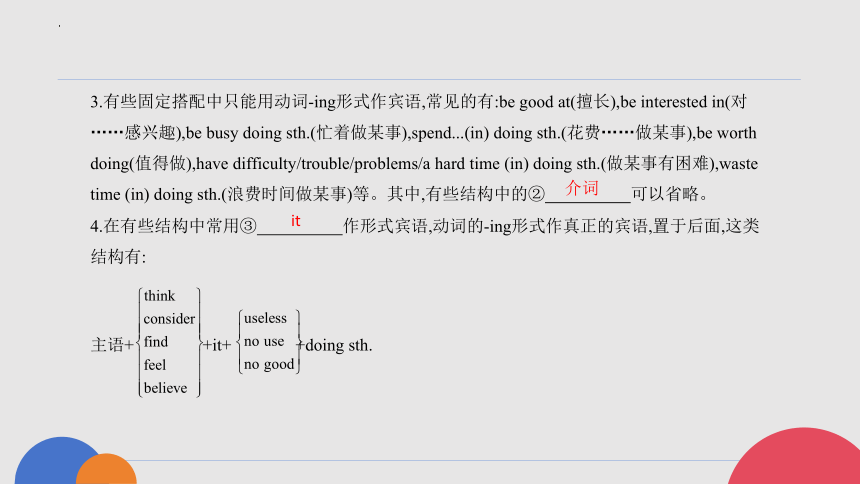
文档简介
(共25张PPT)
Unit 9 语法知识精讲
1 | the+比较级..., the+比较级...
结构
用法归纳
“the+比较级...,the+比较级...”句型,意为“ ”,表示后者随着前
者的变化而变化。其中,前面的“the+比较级...”可以看作表示 的状语从句,后面
的“the+比较级...”可以看作主句,若后面用一般将来时,前面常用一般现在时表将来。前后
都可以有所省略,特别是在谚语、俗语中。
结构拓展
“比较级+and+比较级”结构意为“越来越……”,如果是多音节形容词或副词,则用
“more and more+多音节形容词或副词原级”。
It is getting cooler and cooler.天气越来越凉爽。
As the New Year neared, the children became more and more excited.随着新年的临近,孩子
们变得越来越兴奋。
越……,(就)越……
条件
2 | 强调谓语
Yet, there are some people who do have amazing memories.然而,有些人确实有惊人的记
忆力。
As we all know, Yuan Longping did make great achievements in the hybrid rice research.众所周
知,袁隆平的确在杂交水稻研究上取得了巨大成就。
Do keep calm in case of fire and find the emergency exit.万一失火,务必要保持冷静,找到紧急
出口。
用法归纳
①在肯定句中,将助动词do、does、 放在动词原形前,强调谓语,表示“的确,
确实,真的”。这种强调结构只能用于一般现在时和一般过去时两种时态,且没有疑问和否
定形式。
结构
did
②在祈使句中,“do+动词原形”表示说话人强烈的感情,表示“ ,一定”。
结构拓展
如果强调主语、宾语或状语,可用强调句型:“It is/was+被强调部分+who/that+其他部
分”。
It's everyone who makes a difference in environmental protection.在环境保护中,每个人都能
有所作为。
It was on the social media that we watched the live concert.正是在社交媒体上,我们观看了这
个现场音乐会。
务必
3 | with的复合结构
The teacher came in, with a book in his hand.老师进来了,手里拿着一本书。
You may catch a cold if you often sleep with the windows open.如果你经常开着窗户睡觉,你可
能会感冒。
With my homework finished, I gladly accepted her invitation.由于我的作业做完了,我高兴地接
受了她的邀请。
结构
With much housework to do, she doesn't even have time to go shopping.有很多家务要做,她甚至
没有时间去购物。
That can be dangerous work that could be avoided with drones assisting the crews' efforts.有无人
机帮助工作人员完成这些费力的事,这种危险的工作就可避免。
用法归纳
with的复合结构指的是“with+宾语+宾语补足语”的结构,在句中常作原因、条件、时
间、方式或伴随状语,也可作后置定语。常见形式有:
①with+宾语+ (表示动作将要发生)
②with+宾语+ (表示主动或正在进行)
③with+宾语+ (表示被动或已完成)
④with+宾语+形容词/副词/介词短语(表示状态)
动词不定式(短语)
现在分词(短语)
过去分词(短语)
动词的-ing形式和动词不定式作宾语
一、只能接动词的-ing形式作宾语的动词(短语)
情景导学
From then on, I hated playing the clarinet and I kept getting worse.从那时起,我讨厌吹单簧管,而
且变得越来越糟糕。
I dream of sailing around the world and leading a happy life.我梦想着进行环球航行,过上幸福
的生活。
Mary did not have time to go to the concert last night because she was busy preparing for her ex-
amination.昨天晚上玛丽没时间去听音乐会,因为她当时在忙于为考试做准备。
I found it useless/no use arguing about it.我发现争论这件事没有用。
用法归纳
1.动词的-ing形式常作某些动词(短语)的宾语,这类动词(短语)如下:
考虑(consider)建议(suggest/advise)厌(dislike)原谅(excuse/pardon);
承认(admit)推迟(delay/put off)没得想(fancy);
避免(avoid)错过(miss)坚持(keep)练(practice);
否认(deny)完成(finish)就欣赏(enjoy);
禁止(forbid)想象(imagine)才冒险(risk);
不禁(can't help)介意(mind)准(allow/permit)避开(escape)。
2.一些以① 结尾的动词短语后常跟动词的-ing形式作宾语,这些动词短语包括:
dream of(梦想)、insist on(坚持)、think of(考虑)、aim at(力求)、set about(开始)、be used to
(习惯于)、get down to(开始做)、devote oneself to(献身于)、look forward to(期待)、stick to
(坚持)、pay attention to(注意)等。
介词
3.有些固定搭配中只能用动词-ing形式作宾语,常见的有:be good at(擅长),be interested in(对
……感兴趣),be busy doing sth.(忙着做某事),spend...(in) doing sth.(花费……做某事),be worth
doing(值得做),have difficulty/trouble/problems/a hard time (in) doing sth.(做某事有困难),waste
time (in) doing sth.(浪费时间做某事)等。其中,有些结构中的② 可以省略。
4.在有些结构中常用③ 作形式宾语,动词的-ing形式作真正的宾语,置于后面,这类
结构有:
主语+ +it+ +doing sth.
介词
it
特别提醒
advise、 allow、 permit、 forbid等动词后直接接动词的-ing形式作宾语,但如果后面有名词
或代词作宾语,则其后用动词不定式作宾语补足语。
They don't allow smoking in the office.他们不允许在办公室吸烟。
They don't allow anyone to smoke in the office.他们不允许任何人在办公室吸烟。
二、只能接动词不定式作宾语的动词
情景导学
They managed to finish the work on time.他们设法按时完成了工作。
We agreed to meet here but so far she hasn't turned up yet.我们约好在这里见面,但是她到目前
为止还没有露面。
I find it difficult to do the job well.我发现很难做好这份工作。
用法归纳
1.有些动词后只能跟动词不定式作宾语,这类动词如下:
同意(agree)提出(offer)做打算(plan);
要求(demand)答应(promise)来申请(apply);
准备(prepare)决定(decide)遭拒绝(refuse);
敢于(dare)选择(choose)有希望(wish/hope/want/expect/long);
不能做到(fail)莫假装(pretend);
设法做成(manage)决心(determine)强;
恳求(beg)安排(arrange)又威胁(threaten);
声称(claim)力争(aim)不犹豫(hesitate)。
2.在有些结构中常用④ 作形式宾语,动词不定式作真正的宾语,置于后面,这类结
构为:主语+动词(think/find/feel/consider/make/regard/...)+it+宾语补足语+动词不定式。
it
三、既可跟动词的-ing形式又可跟动词不定式作宾语的动词(短语)
情景导学
They continued discussing/to discuss the plan after having a rest.休息了一会儿后,他们继续讨论
这个计划。
Don't you remember telling me the story yesterday 难道你不记得昨天给我讲过这个故事了
吗
Please remember to give my best regards to your family.请记得代我向你的家人问好。
用法归纳
1.有些动词后既可跟动词的-ing形式又可跟动词不定式作宾语,且意义差别⑤ (不
大/很大),这类动词有:begin、start、continue、prefer、like、love、hate等。
不大
2.有些动词(短语)后既可跟动词的-ing形式又可跟动词不定式作宾语,且意义差别⑥
(不大/很大),这类动词(短语)有:
很大
主谓一致
一、意义一致原则
意义一致原则是指主语在意义上的单、复数决定谓语动词的形式。
情景导学1
Twenty years is a long time.二十年是很长的一段时间。
用法归纳1
意义一致原则主要指谓语动词的形式取决于主语的意义,形式上为单数但意义上为复数
的主语,谓语动词用复数,形式上为复数但意义上为单数的主语,谓语动词用单数。
情景导学2
The class consists of forty people.这个班由四十人组成。
My family are all seafood lovers.我的家人都喜欢吃海鲜。
用法归纳2
当集体名词family、class、crew、team、group、army、crowd、committee、staff、pub-
lic、majority等作主语时,如果表示整体概念,谓语动词用① 形式。如果强调其成
员,谓语动词用② 形式。
情景导学3
The manager and the secretary have agreed to be present.经理和秘书已同意出席。
Early to bed and early to rise makes a man healthy, wealthy and wise.早睡早起使人健康、富有
和聪明。
用法归纳3
and连接两个并列成分作主语,如果在意义上指同一人、同一物、同一事情或者同一概
念,谓语动词用③ 形式;如果是指两个不同的人或两种不同的事物,谓语动词用
单数
复数
单数
④ 形式。
特别提醒
“the+形容词/过去分词”作主语时,如果表示一类人,谓语动词用复数形式;如果表示抽象概
念时,谓语动词用单数形式。
The poor need more support from society.穷人需要社会更多的支持。
The new is sure to take place of the old.新生事物一定会代替旧事物。
复数
二、语法一致原则
语法一致原则是指谓语动词的形式和主语在语法形式上保持一致。
情景导学1
To see is to believe.眼见为实。
Writing an essay is a difficult process for most people.写文章对于大多数人来说是一个艰难的
过程。 (2022全国新高考Ⅱ)
用法归纳1
单个动名词(短语)、不定式(短语)或名词性从句充当主语时,谓语动词常用⑤
形式。
情景导学2
The bat, as well as the balls, has been stolen.球棒和球都被偷了。
单数
The driver, rather than passers-by, is to blame.该承担责任的人是司机,而不是路人。
用法归纳2
由⑥ 、(along/together) with、except、but、rather than连接两个名词或代词
作主语时,谓语动词的单复数与⑦ (前面/后面)的名词或代词保持一致。
情景导学3
Many a method has been tried to reduce pollution.人们已经尝试了许多方法来减少污染。
Every hour and every minute is significant.每一小时、每一分钟都很重要。
用法归纳3
以下结构作主语时,谓语动词用单数形式:
(1)⑧ /more than one/each/every/either/neither+单数名词。
(2)no/each/every+单数名词+and(+no/each/every)+单数名词。
as well as
前面
many a
情景导学4
Only one third of the work was done yesterday.昨天只完成了三分之一的工作。
Around 90 percent of the volunteers are university students in the activity.在这场活动中大约9
0%的志愿者是大学生。
This new type of smart car is now on show.这种新型的智能汽车正在展出。
Quantities of money are needed to equip the hospital.为这家医院配备设施需要大量的钱。
用法归纳4
(1)由“a lot/most/plenty/half/the rest/a (large/small) quantity of+名词”以及“分数/百分数+of
+名词”构成的短语作主语时,谓语动词的单复数取决于of后的名词,如果名词是⑨
名词,则谓语动词用单数形式;如果of后的名词是复数名词,则谓语动词用复数形式。
(2)quantities of后接复数名词或不可数名词作主语时,谓语动词通常用 形式。
不可数
复数
(3)由“... /kind/form/sort of+名词”作主语时,谓语动词的数常取决于of前的这
些词的单复数。
情景导学5
Now a number of his partners are starting to join him as well.现在,他的一些合作伙伴也开始加
入他的行列。
The number of customers is getting larger and larger.顾客的数量越来越多。
He is one of the students who major in biology.他是主修生物学的学生之一。
He is the only one of the children who has a gift for music.他是这些孩子中唯一有音乐天赋的
孩子。
It is the boys who are responsible for the accident.是这些男孩应为这次事故负责。
type
用法归纳5
(1)“the number of+复数名词”作主语时,谓语动词用 形式,表示“……的数
量”。“a (great/large) number of+复数名词”作主语时,谓语动词用复数形式,表示“大量的
……”。
(2)在定语从句中,关系代词that、who、which作主语时,从句谓语动词的数应与
的数保持一致。
(3)在强调句型“It is/was+被强调部分+that/who+其他部分”中,当被强调部分是主语时,谓语
动词的数应与被强调的主语保持一致。
单数
先行词
三、就近一致原则
就近一致原则是指谓语动词的人称和数与离其最近的主语保持一致。
情景导学
Either I or you are in charge of this task.不是我就是你负责这项任务。
There is a table and two chairs in the yard.院子里有一张桌子和两把椅子。
用法归纳
(1)连词or、 、neither...nor...、not...but...、not only...but (also)...等连接两个名
词或代词作主语时,谓语动词的形式常与离其最近的主语保持一致。
(2) 、here be句型中有多个主语时,谓语动词的形式常与离其最近的主语保持
一致。
either..or...
there be
即时巩固
单句语法填空
1.The way you handle chopsticks is important to avoid (annoy) your
companions.
2.However, some high sugar brands, like Classic Coca Cola, have accepted the
sugar tax and are refusing (change) for fear of upsetting consumers.
3.Fearing that I would pick out something awful, I desperately tried (ask)
the boy ahead of me for a recommendation.
4.The wind picked up and thunder rolled. My husband stopped
(fish) to start the motor.
5.The children failed (hide) their disappointment when they found out the
annoying
to change
to ask
fishing
to hide
school had cancelled the party.
6.Critical reasoning, together with problem-solving, (prepare) teenagers
to make better decisions.
7.It was one of my kindergarteners who I thought (be) absent that day.
8.Helping the next generation to have a healthy and active childhood
(be) of great importance.
9.The number of medical schools reached 18 in the early 1990s and
(remain) around that level ever since.
10.Tom as well as two of his classmates (be) invited to the party last week.
prepares
was
is
has remained
was
Unit 9 语法知识精讲
1 | the+比较级..., the+比较级...
结构
用法归纳
“the+比较级...,the+比较级...”句型,意为“ ”,表示后者随着前
者的变化而变化。其中,前面的“the+比较级...”可以看作表示 的状语从句,后面
的“the+比较级...”可以看作主句,若后面用一般将来时,前面常用一般现在时表将来。前后
都可以有所省略,特别是在谚语、俗语中。
结构拓展
“比较级+and+比较级”结构意为“越来越……”,如果是多音节形容词或副词,则用
“more and more+多音节形容词或副词原级”。
It is getting cooler and cooler.天气越来越凉爽。
As the New Year neared, the children became more and more excited.随着新年的临近,孩子
们变得越来越兴奋。
越……,(就)越……
条件
2 | 强调谓语
Yet, there are some people who do have amazing memories.然而,有些人确实有惊人的记
忆力。
As we all know, Yuan Longping did make great achievements in the hybrid rice research.众所周
知,袁隆平的确在杂交水稻研究上取得了巨大成就。
Do keep calm in case of fire and find the emergency exit.万一失火,务必要保持冷静,找到紧急
出口。
用法归纳
①在肯定句中,将助动词do、does、 放在动词原形前,强调谓语,表示“的确,
确实,真的”。这种强调结构只能用于一般现在时和一般过去时两种时态,且没有疑问和否
定形式。
结构
did
②在祈使句中,“do+动词原形”表示说话人强烈的感情,表示“ ,一定”。
结构拓展
如果强调主语、宾语或状语,可用强调句型:“It is/was+被强调部分+who/that+其他部
分”。
It's everyone who makes a difference in environmental protection.在环境保护中,每个人都能
有所作为。
It was on the social media that we watched the live concert.正是在社交媒体上,我们观看了这
个现场音乐会。
务必
3 | with的复合结构
The teacher came in, with a book in his hand.老师进来了,手里拿着一本书。
You may catch a cold if you often sleep with the windows open.如果你经常开着窗户睡觉,你可
能会感冒。
With my homework finished, I gladly accepted her invitation.由于我的作业做完了,我高兴地接
受了她的邀请。
结构
With much housework to do, she doesn't even have time to go shopping.有很多家务要做,她甚至
没有时间去购物。
That can be dangerous work that could be avoided with drones assisting the crews' efforts.有无人
机帮助工作人员完成这些费力的事,这种危险的工作就可避免。
用法归纳
with的复合结构指的是“with+宾语+宾语补足语”的结构,在句中常作原因、条件、时
间、方式或伴随状语,也可作后置定语。常见形式有:
①with+宾语+ (表示动作将要发生)
②with+宾语+ (表示主动或正在进行)
③with+宾语+ (表示被动或已完成)
④with+宾语+形容词/副词/介词短语(表示状态)
动词不定式(短语)
现在分词(短语)
过去分词(短语)
动词的-ing形式和动词不定式作宾语
一、只能接动词的-ing形式作宾语的动词(短语)
情景导学
From then on, I hated playing the clarinet and I kept getting worse.从那时起,我讨厌吹单簧管,而
且变得越来越糟糕。
I dream of sailing around the world and leading a happy life.我梦想着进行环球航行,过上幸福
的生活。
Mary did not have time to go to the concert last night because she was busy preparing for her ex-
amination.昨天晚上玛丽没时间去听音乐会,因为她当时在忙于为考试做准备。
I found it useless/no use arguing about it.我发现争论这件事没有用。
用法归纳
1.动词的-ing形式常作某些动词(短语)的宾语,这类动词(短语)如下:
考虑(consider)建议(suggest/advise)厌(dislike)原谅(excuse/pardon);
承认(admit)推迟(delay/put off)没得想(fancy);
避免(avoid)错过(miss)坚持(keep)练(practice);
否认(deny)完成(finish)就欣赏(enjoy);
禁止(forbid)想象(imagine)才冒险(risk);
不禁(can't help)介意(mind)准(allow/permit)避开(escape)。
2.一些以① 结尾的动词短语后常跟动词的-ing形式作宾语,这些动词短语包括:
dream of(梦想)、insist on(坚持)、think of(考虑)、aim at(力求)、set about(开始)、be used to
(习惯于)、get down to(开始做)、devote oneself to(献身于)、look forward to(期待)、stick to
(坚持)、pay attention to(注意)等。
介词
3.有些固定搭配中只能用动词-ing形式作宾语,常见的有:be good at(擅长),be interested in(对
……感兴趣),be busy doing sth.(忙着做某事),spend...(in) doing sth.(花费……做某事),be worth
doing(值得做),have difficulty/trouble/problems/a hard time (in) doing sth.(做某事有困难),waste
time (in) doing sth.(浪费时间做某事)等。其中,有些结构中的② 可以省略。
4.在有些结构中常用③ 作形式宾语,动词的-ing形式作真正的宾语,置于后面,这类
结构有:
主语+ +it+ +doing sth.
介词
it
特别提醒
advise、 allow、 permit、 forbid等动词后直接接动词的-ing形式作宾语,但如果后面有名词
或代词作宾语,则其后用动词不定式作宾语补足语。
They don't allow smoking in the office.他们不允许在办公室吸烟。
They don't allow anyone to smoke in the office.他们不允许任何人在办公室吸烟。
二、只能接动词不定式作宾语的动词
情景导学
They managed to finish the work on time.他们设法按时完成了工作。
We agreed to meet here but so far she hasn't turned up yet.我们约好在这里见面,但是她到目前
为止还没有露面。
I find it difficult to do the job well.我发现很难做好这份工作。
用法归纳
1.有些动词后只能跟动词不定式作宾语,这类动词如下:
同意(agree)提出(offer)做打算(plan);
要求(demand)答应(promise)来申请(apply);
准备(prepare)决定(decide)遭拒绝(refuse);
敢于(dare)选择(choose)有希望(wish/hope/want/expect/long);
不能做到(fail)莫假装(pretend);
设法做成(manage)决心(determine)强;
恳求(beg)安排(arrange)又威胁(threaten);
声称(claim)力争(aim)不犹豫(hesitate)。
2.在有些结构中常用④ 作形式宾语,动词不定式作真正的宾语,置于后面,这类结
构为:主语+动词(think/find/feel/consider/make/regard/...)+it+宾语补足语+动词不定式。
it
三、既可跟动词的-ing形式又可跟动词不定式作宾语的动词(短语)
情景导学
They continued discussing/to discuss the plan after having a rest.休息了一会儿后,他们继续讨论
这个计划。
Don't you remember telling me the story yesterday 难道你不记得昨天给我讲过这个故事了
吗
Please remember to give my best regards to your family.请记得代我向你的家人问好。
用法归纳
1.有些动词后既可跟动词的-ing形式又可跟动词不定式作宾语,且意义差别⑤ (不
大/很大),这类动词有:begin、start、continue、prefer、like、love、hate等。
不大
2.有些动词(短语)后既可跟动词的-ing形式又可跟动词不定式作宾语,且意义差别⑥
(不大/很大),这类动词(短语)有:
很大
主谓一致
一、意义一致原则
意义一致原则是指主语在意义上的单、复数决定谓语动词的形式。
情景导学1
Twenty years is a long time.二十年是很长的一段时间。
用法归纳1
意义一致原则主要指谓语动词的形式取决于主语的意义,形式上为单数但意义上为复数
的主语,谓语动词用复数,形式上为复数但意义上为单数的主语,谓语动词用单数。
情景导学2
The class consists of forty people.这个班由四十人组成。
My family are all seafood lovers.我的家人都喜欢吃海鲜。
用法归纳2
当集体名词family、class、crew、team、group、army、crowd、committee、staff、pub-
lic、majority等作主语时,如果表示整体概念,谓语动词用① 形式。如果强调其成
员,谓语动词用② 形式。
情景导学3
The manager and the secretary have agreed to be present.经理和秘书已同意出席。
Early to bed and early to rise makes a man healthy, wealthy and wise.早睡早起使人健康、富有
和聪明。
用法归纳3
and连接两个并列成分作主语,如果在意义上指同一人、同一物、同一事情或者同一概
念,谓语动词用③ 形式;如果是指两个不同的人或两种不同的事物,谓语动词用
单数
复数
单数
④ 形式。
特别提醒
“the+形容词/过去分词”作主语时,如果表示一类人,谓语动词用复数形式;如果表示抽象概
念时,谓语动词用单数形式。
The poor need more support from society.穷人需要社会更多的支持。
The new is sure to take place of the old.新生事物一定会代替旧事物。
复数
二、语法一致原则
语法一致原则是指谓语动词的形式和主语在语法形式上保持一致。
情景导学1
To see is to believe.眼见为实。
Writing an essay is a difficult process for most people.写文章对于大多数人来说是一个艰难的
过程。 (2022全国新高考Ⅱ)
用法归纳1
单个动名词(短语)、不定式(短语)或名词性从句充当主语时,谓语动词常用⑤
形式。
情景导学2
The bat, as well as the balls, has been stolen.球棒和球都被偷了。
单数
The driver, rather than passers-by, is to blame.该承担责任的人是司机,而不是路人。
用法归纳2
由⑥ 、(along/together) with、except、but、rather than连接两个名词或代词
作主语时,谓语动词的单复数与⑦ (前面/后面)的名词或代词保持一致。
情景导学3
Many a method has been tried to reduce pollution.人们已经尝试了许多方法来减少污染。
Every hour and every minute is significant.每一小时、每一分钟都很重要。
用法归纳3
以下结构作主语时,谓语动词用单数形式:
(1)⑧ /more than one/each/every/either/neither+单数名词。
(2)no/each/every+单数名词+and(+no/each/every)+单数名词。
as well as
前面
many a
情景导学4
Only one third of the work was done yesterday.昨天只完成了三分之一的工作。
Around 90 percent of the volunteers are university students in the activity.在这场活动中大约9
0%的志愿者是大学生。
This new type of smart car is now on show.这种新型的智能汽车正在展出。
Quantities of money are needed to equip the hospital.为这家医院配备设施需要大量的钱。
用法归纳4
(1)由“a lot/most/plenty/half/the rest/a (large/small) quantity of+名词”以及“分数/百分数+of
+名词”构成的短语作主语时,谓语动词的单复数取决于of后的名词,如果名词是⑨
名词,则谓语动词用单数形式;如果of后的名词是复数名词,则谓语动词用复数形式。
(2)quantities of后接复数名词或不可数名词作主语时,谓语动词通常用 形式。
不可数
复数
(3)由“... /kind/form/sort of+名词”作主语时,谓语动词的数常取决于of前的这
些词的单复数。
情景导学5
Now a number of his partners are starting to join him as well.现在,他的一些合作伙伴也开始加
入他的行列。
The number of customers is getting larger and larger.顾客的数量越来越多。
He is one of the students who major in biology.他是主修生物学的学生之一。
He is the only one of the children who has a gift for music.他是这些孩子中唯一有音乐天赋的
孩子。
It is the boys who are responsible for the accident.是这些男孩应为这次事故负责。
type
用法归纳5
(1)“the number of+复数名词”作主语时,谓语动词用 形式,表示“……的数
量”。“a (great/large) number of+复数名词”作主语时,谓语动词用复数形式,表示“大量的
……”。
(2)在定语从句中,关系代词that、who、which作主语时,从句谓语动词的数应与
的数保持一致。
(3)在强调句型“It is/was+被强调部分+that/who+其他部分”中,当被强调部分是主语时,谓语
动词的数应与被强调的主语保持一致。
单数
先行词
三、就近一致原则
就近一致原则是指谓语动词的人称和数与离其最近的主语保持一致。
情景导学
Either I or you are in charge of this task.不是我就是你负责这项任务。
There is a table and two chairs in the yard.院子里有一张桌子和两把椅子。
用法归纳
(1)连词or、 、neither...nor...、not...but...、not only...but (also)...等连接两个名
词或代词作主语时,谓语动词的形式常与离其最近的主语保持一致。
(2) 、here be句型中有多个主语时,谓语动词的形式常与离其最近的主语保持
一致。
either..or...
there be
即时巩固
单句语法填空
1.The way you handle chopsticks is important to avoid (annoy) your
companions.
2.However, some high sugar brands, like Classic Coca Cola, have accepted the
sugar tax and are refusing (change) for fear of upsetting consumers.
3.Fearing that I would pick out something awful, I desperately tried (ask)
the boy ahead of me for a recommendation.
4.The wind picked up and thunder rolled. My husband stopped
(fish) to start the motor.
5.The children failed (hide) their disappointment when they found out the
annoying
to change
to ask
fishing
to hide
school had cancelled the party.
6.Critical reasoning, together with problem-solving, (prepare) teenagers
to make better decisions.
7.It was one of my kindergarteners who I thought (be) absent that day.
8.Helping the next generation to have a healthy and active childhood
(be) of great importance.
9.The number of medical schools reached 18 in the early 1990s and
(remain) around that level ever since.
10.Tom as well as two of his classmates (be) invited to the party last week.
prepares
was
is
has remained
was
同课章节目录
- Unit 7 Art
- Lesson 1 Masterpieces
- Lesson 2 Beijing Opera
- Lesson 3 A Musical Genius
- Unit 8 Green living
- Lesson 1 Roots and Shoots
- Lesson 2 Greening the Desert
- Lesson 3 "White Bikes" on the Road
- Unit 9 Learning
- Lesson 1 Active Learning
- Lesson 2 Language Learning Tips
- Lesson 3 The Secrets of Your Memory
